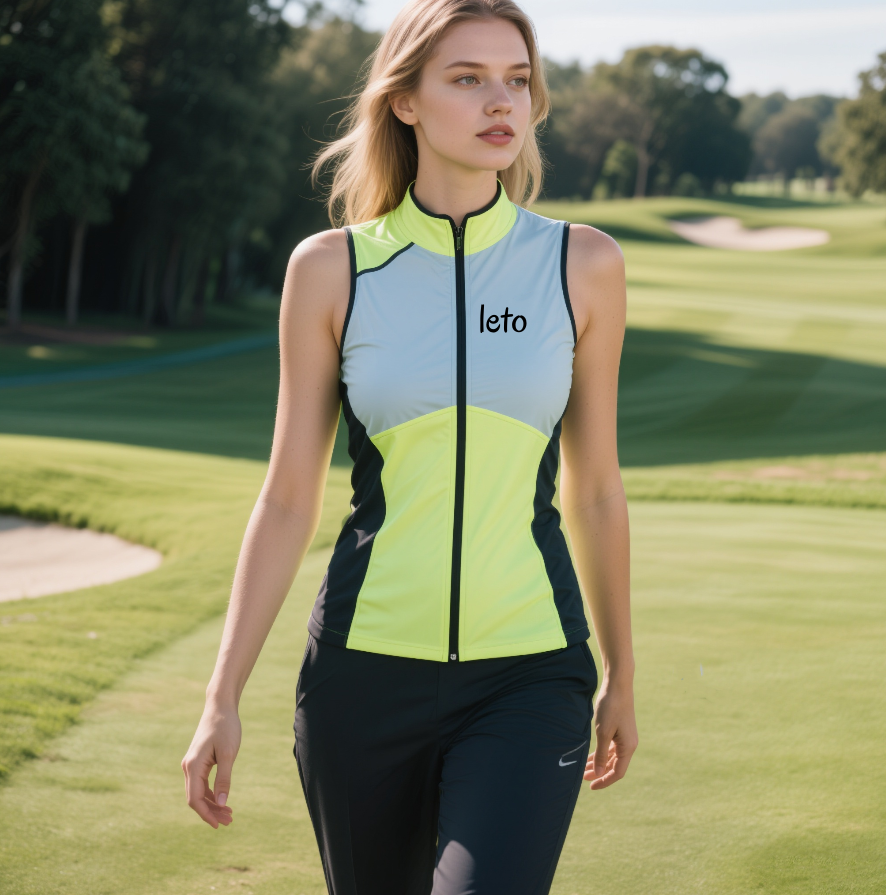The golf apparel industry is experiencing unprecedented growth, with the global market valued at USD 4.24 billion in 2023 and expected to grow at a CAGR of 6.2%. For golf apparel startups, established brands, and procurement managers, understanding how to effectively source from custom golf clothing suppliers has become crucial for success in this competitive landscape.
Understanding the Modern Golf Apparel Manufacturing Landscape

The golf clothing manufacturing sector has evolved dramatically, with suppliers now offering sophisticated solutions that cater to diverse business needs. Today's golf clothing manufacturers like Leto specialize in providing comprehensive OEM/ODM services, combining advanced printing and embroidery equipment with meticulous attention to detail.
Key Market Drivers Shaping the Industry:
Sustainability in golf apparel has become a dominant trend, with manufacturers adopting eco-friendly materials such as recycled polyester and biodegradable fabrics. This shift toward sustainable golf apparel reflects growing consumer awareness about environmental impact, making eco-friendly golf apparel essential for environmentally conscious brands.
The emphasis on performance innovation has led to breakthroughs in fabric technology, including graphene-infused golf wear temperature control systems and 4-way stretch golf pants meeting ISO 13934 standards. These technical advances ensure that modern golf apparel delivers superior functionality while maintaining the aesthetic appeal demanded by today's golfers.
Identifying the Right Golf Clothing Supplier for Your Business
When evaluating potential golf clothing suppliers, several critical factors distinguish exceptional manufacturers from average ones:
Manufacturing Capabilities and Quality Standards:

The best golf clothing manufacturers operate BSCI audited golf wear factories, ensuring ethical labor practices and quality control. These facilities typically employ skilled craftsmanship techniques and maintain certifications for specialized testing, such as AATCC 183 UV test methodology for sun protection verification.
Premium golf fabrics form the foundation of exceptional golf apparel. Leading suppliers maintain partnerships with textile mills that produce innovative materials, from lightweight golf vest tournament legal designs to sweat-resistant golf wear for tropical climates. The ability to source and work with these advanced materials separates professional manufacturers from basic suppliers.
Minimum Order Quantities and Flexibility:
For golf apparel startups and smaller brands, low MOQ golf apparel options starting from 50 pieces have become increasingly important. Many manufacturers now offer low MOQ alternatives starting from just 50 pieces, providing the flexibility essential for new brands. This accessibility allows emerging companies to test market demand without significant financial risk.
Similarly, embroidery golf hat minimum quantities for embroidered golf hats have decreased, with many suppliers accepting orders as small as 25-50 pieces for custom embroidered golf apparel. This flexibility enables brands to offer personalized golf wear without excessive inventory commitments.
Custom Design Solutions and Technical Specifications

Modern golf clothing suppliers excel in providing custom golf wear solutions that address specific performance requirements. These capabilities extend beyond basic customization to include:
Advanced Fabric Technologies:
The integration of smart textiles has revolutionized golf apparel design. Windproof golf jackets for coastal tournaments now incorporate breathable membranes that block wind while allowing moisture vapor transmission. Non-restrictive golf polo designs feature full swing mobility through strategic fabric placement and seam construction.
Custom Logo Sport Golf Shirt Production:

Professional suppliers maintain extensive decoration capabilities, including multi-head embroidery machines for custom embroidered golf polo shirts and advanced screen printing systems for complex logo applications. The ability to reproduce brand logos with precision across different fabric types and colors demonstrates manufacturing sophistication.
Specialized Applications:
Unique ladies' golf apparel requires an understanding of fit preferences and style trends specific to female golfers. Cute golf outfits for ladies have evolved beyond traditional designs to include fashion-forward silhouettes that maintain performance functionality. Ladies' golf apparel brands increasingly demand suppliers capable of producing both classic and trendy golf apparel designs.
Quality Control and Manufacturing Excellence

Efficient manufacturing processes distinguish professional golf clothing suppliers from generic apparel manufacturers. These systems encompass:
Production Management:
Experienced suppliers implement comprehensive project management systems that track orders from initial design approval through final shipment. This includes regular communication checkpoints, quality inspection protocols, and on-time delivery guarantees that support business planning requirements.
Testing and Certification:
Professional golf wear factories conduct extensive testing throughout the production process. This includes fabric performance testing, colorfastness verification, and durability assessments that ensure finished products meet specified standards. UV protection testing using AATCC 183 methodology has become standard for outdoor golf apparel.
Skilled Craftsmanship Standards:

The construction quality of golf apparel directly impacts performance and durability. Expert manufacturers employ trained operators who understand golf-specific design requirements, such as reinforced stress points for swing motion and strategic ventilation placement for thermal management.
Sourcing Strategies for Different Business Models
Startup Golf Apparel Brands:

New golf apparel companies benefit from suppliers offering comprehensive design support and low minimum orders. The ability to develop custom golf wear solutions with minimal initial investment allows startups to establish market presence while refining their product offerings.
Design development services become particularly valuable for companies lacking in-house design capabilities. Professional suppliers provide technical design support, fabric recommendations, and fit optimization services that accelerate product development timelines.
Established Brand Requirements:

Mature golf apparel companies typically require suppliers capable of handling larger volume production while maintaining consistent quality standards. These partnerships often involve seasonal collection development, where suppliers contribute technical expertise and manufacturing efficiency to support brand growth objectives.
Country Club and Corporate Uniform Programs:
Country club uniform redesign case studies demonstrate the importance of supplier flexibility and service orientation. Successful suppliers work closely with club management to develop custom solutions that reflect brand identity while meeting practical performance requirements. This includes coordinating with club staff for fitting sessions and managing inventory replenishment programs.
Sustainable and Innovative Manufacturing Practices

The emphasis on eco-friendly fabrics and ethical production practices has intensified, with many brands adopting recycled materials to create high-performance golf apparel. Recycled golf apparel suppliers now offer sophisticated options that match traditional fabric performance while reducing environmental impact.
Organic cotton golf wear suppliers serve eco-conscious retailers seeking sustainable alternatives to conventional materials. These suppliers maintain certifications for organic fiber sourcing and employ environmentally responsible processing methods throughout production.
Innovation in Golf Fashion:

Golf fashion brands are introducing wearable technology trends, including UV-sensing clothing and AI-based swing-enhancing clothing. Forward-thinking suppliers invest in research and development to incorporate these technologies into mainstream golf apparel production.
The concept of innovative golf fashion extends beyond technology integration to include aesthetic innovation. Bold colors, unique patterns, and unconventional design elements are becoming acceptable in golf fashion, requiring suppliers capable of executing creative design concepts while maintaining performance standards.
Building Long-Term Supplier Partnerships

Successful golf apparel sourcing requires developing strategic partnerships rather than transactional supplier relationships. Key elements of effective partnerships include:
Communication and Collaboration:
Regular communication ensures alignment between brand objectives and manufacturing capabilities. Professional suppliers provide detailed production updates, proactive problem-solving support, and technical guidance that contributes to product development success.
Quality Partnership Development:
Long-term relationships enable suppliers to understand brand-specific quality standards and customer preferences. This institutional knowledge improves production efficiency and reduces quality-related issues over time.
Capacity Planning and Scalability:
As golf apparel brands grow, suppliers must demonstrate the ability to scale production capacity accordingly. This includes facility expansion capabilities, workforce development programs, and supply chain management systems that support increased volume requirements.
Future Trends and Considerations

The golf apparel manufacturing landscape continues evolving, with several trends shaping future sourcing strategies:
Technology Integration:
Advanced manufacturing technologies, including automated cutting systems and digital printing capabilities, are becoming standard requirements for competitive suppliers. These technologies improve production efficiency while enabling greater customization capabilities.
Luxury Market Expansion:

Luxury golf apparel brands' ladies segment represents a growing opportunity for suppliers capable of producing premium-quality garments. This market demands exceptional attention to detail, premium materials, and sophisticated construction techniques that justify higher price points.
Global Supply Chain Adaptation:
Recent global events have emphasized the importance of supply chain resilience. Successful golf apparel brands are developing relationships with multiple suppliers across different geographic regions to ensure production continuity and risk mitigation.
Conclusion: Partnering for Success

Sourcing from custom golf clothing suppliers requires understanding the complex interplay between design requirements, manufacturing capabilities, and market demands. Companies like Leto Golf Manufacturing exemplify the comprehensive approach needed for successful golf apparel production, combining advanced equipment capabilities with skilled craftsmanship and customer-focused service delivery.
The key to successful sourcing lies in identifying suppliers who understand your specific business requirements, whether you're launching a new golf apparel startup with low MOQ needs or managing complex production requirements for an established brand. Professional suppliers offer the technical expertise, manufacturing flexibility, and service commitment necessary to navigate today's competitive golf apparel marketplace successfully.
By focusing on quality, sustainability, innovation, and partnership development, brands can build supplier relationships that support long-term growth and market success. The golf apparel industry's continued expansion creates opportunities for companies that invest in professional manufacturing partnerships and maintain a commitment to delivering exceptional products that meet evolving customer expectations.
Post time: 25-07-19








